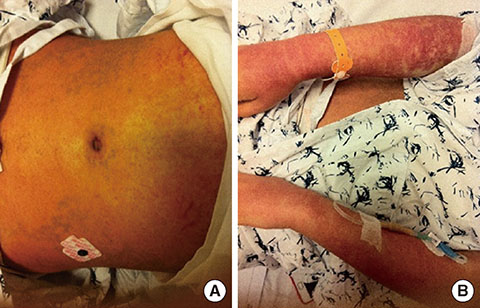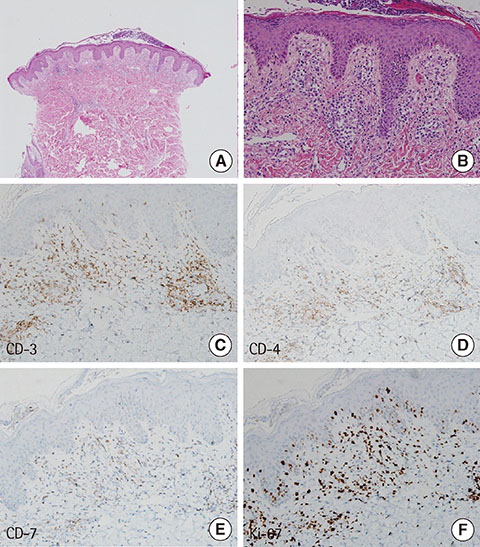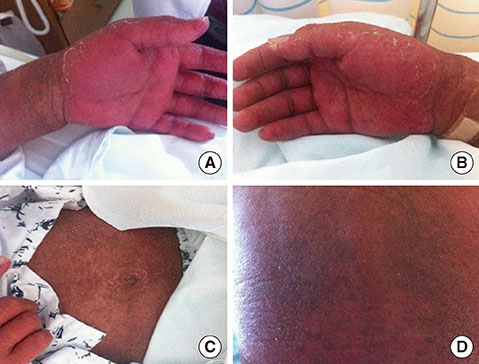Allergy Asthma Respir Dis.
2013 Dec;1(4):400-404. 10.4168/aard.2013.1.4.400.
Dapsone-induced drug reaction with eosinophilia and systemic symptoms syndrome, misdiagnosed as lymphoma
- Affiliations
-
- 1Department of Allergy and Clinical Immunology, Asan Medical Center, Seoul, Korea. kwonhs21@naver.com
- 2Department of Internal Medicine, Asan Medical Center, Seoul, Korea.
- KMID: 2262602
- DOI: http://doi.org/10.4168/aard.2013.1.4.400
Abstract
- Drug reaction with eosinophilia and systemic symptoms (DRESS) syndrome is a life-threatening adverse drug reaction with systemic manifestations. Dapsone is known to be useful for treatment of leprosy and various dermatologic conditions. We report a patient with prurigo pigmentosa who developed DRESS syndrome after dapsone treatment. She presented with lymphadenopathy, fever, eosinophilia, skin rash, and elevated liver enzymes. Initial lymph node and skin biopsy was suggestive of peripheral T-cell lymphoma. Initially, she was treated with chemotherapy. A week later after complete remission of skin symptoms, new skin lesions recurred. TCR-gene rearrangement was examined to show negative results and she was diagnosed as dapsone induced DRESS syndrome. This case emphasizes the importance of differential diagnosis of lymphoma and DRESS syndrome.
Keyword
MeSH Terms
Figure
Reference
-
1. Cacoub P, Musette P, Descamps V, Meyer O, Speirs C, Finzi L, et al. The DRESS syndrome: a literature review. Am J Med. 2011; 124:588–597.
Article2. Chen YC, Chiu HC, Chu CY. Drug reaction with eosinophilia and systemic symptoms: a retrospective study of 60 cases. Arch Dermatol. 2010; 146:1373–1379.
Article3. Kardaun SH, Sidoroff A, Valeyrie-Allanore L, Halevy S, Davidovici BB, Mockenhaupt M, et al. Variability in the clinical pattern of cutaneous side-effects of drugs with systemic symptoms: does a DRESS syndrome really exist? Br J Dermatol. 2007; 156:609–611.
Article4. Zhu YI, Stiller MJ. Dapsone and sulfones in dermatology: overview and update. J Am Acad Dermatol. 2001; 45:420–434.
Article5. Kosseifi SG, Guha B, Nassour DN, Chi DS, Krishnaswamy G. The Dapsone hypersensitivity syndrome revisited: a potentially fatal multisystem disorder with prominent hepatopulmonary manifestations. J Occup Med Toxicol. 2006; 1:9.
Article6. Chalasani P, Baffoe-Bonnie H, Jurado RL. Dapsone therapy causing sulfone syndrome and lethal hepatic failure in an HIV-infected patient. South Med J. 1994; 87:1145–1146.
Article7. Mockenhaupt M. Severe drug-induced skin reactions: clinical pattern, diagnostics and therapy. J Dtsch Dermatol Ges. 2009; 7:142–160.
Article8. Chiou CC, Yang LC, Hung SI, Chang YC, Kuo TT, Ho HC, et al. Clinicopathological features and prognosis of drug rash with eosinophilia and systemic symptoms: a study of 30 cases in Taiwan. J Eur Acad Dermatol Venereol. 2008; 22:1044–1049.
Article9. Kardaun SH, Sekula P, Valeyrie-Allanore L, Liss Y, Chu CY, Creamer D, et al. Drug reaction with eosinophilia and systemic symptoms (DRESS): an original multisystem adverse drug reaction. Results from the prospective RegiSCAR study. Br J Dermatol. 2013; 169:1071–1080.
Article10. Lorenz M, Wozel G, Schmitt J. Hypersensitivity reactions to dapsone: a systematic review. Acta Derm Venereol. 2012; 92:194–199.
Article11. Jeung YJ, Lee JY, Oh MJ, Choi DC, Lee BJ. Comparison of the causes and clinical features of drug rash with eosinophilia and systemic symptoms and stevens-johnson syndrome. Allergy Asthma Immunol Res. 2010; 2:123–126.
Article12. Choi HW, Song IK, Chung EA, Cha DY, Lim MK, Na DJ, et al. A case of Sulfone syndrome hypersensitivity associated with dapsone. J Asthma Allergy Clin Immunol. 2001; 21:1206–1210.13. Agrawal S, Agarwalla A. Dapsone hypersensitivity syndrome: a clinico-epidemiological review. J Dermatol. 2005; 32:883–889.
Article14. Schnetzke U, Bossert T, Scholl S, Freesmeyer M, Hochhaus A, La Rosee P. Drug-induced lymphadenopathy with eosinophilia and renal failure mimicking lymphoma disease: dramatic onset of DRESS syndrome associated with antibiotic treatment. Ann Hematol. 2011; 90:1353–1355.
Article15. Rim MY, Hong J, Yo I, Park H, Chung DH, Ahn JY, et al. Cervical lymphadenopathy mimicking angioimmunoblastic T-cell lymphoma after Dapsone-induced hypersensitivity syndrome. Korean J Pathol. 2012; 46:606–610.
Article16. Husain Z, Reddy BY, Schwartz RA. DRESS syndrome: Part I. clinical perspectives. J Am Acad Dermatol. 2013; 68:693.e1–693.e14.17. Sylvia LM. Adverse cutaneous drug eruptions. Ann Pharmacother. 2012; [Epub ahead of print].18. Boone E, Verhaaf B, Langerak AW. PCR-based analysis of rearranged immunoglobulin or T-cell receptor genes by GeneScan analysis or heteroduplex analysis for clonality assessment in lymphoma diagnostics. Methods Mol Biol. 2013; 971:65–91.
Article
- Full Text Links
- Actions
-
Cited
- CITED
-
- Close
- Share
- Similar articles
-
- Rasagiline Induced Drug Rash with Eosinophilia and Systemic Symptoms Syndrome: A Case Report
- A Case of Sitagliptin Induced DRESS Syndrome
- Drug Reaction with Eosinophilia and Systemic Symptom Syndrome Due to Everolimus: A Case Report
- A Case of Fatal DRESS Syndrome Caused by Dapsone in a Patient with Behcet's Syndrome
- Propylthiouracil Induced Drug Reaction with Eosinophilia and Systemic Symptoms (DRESS) in Graves' Disease






